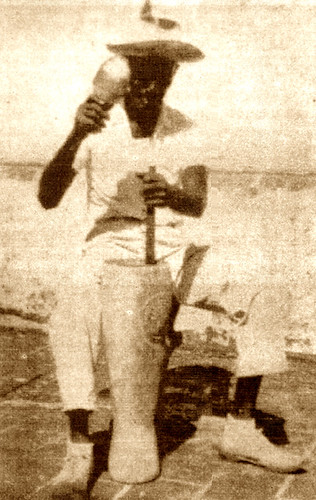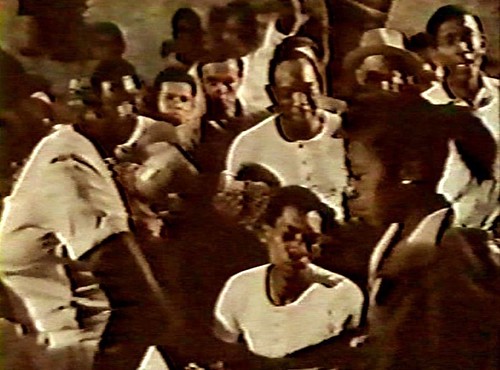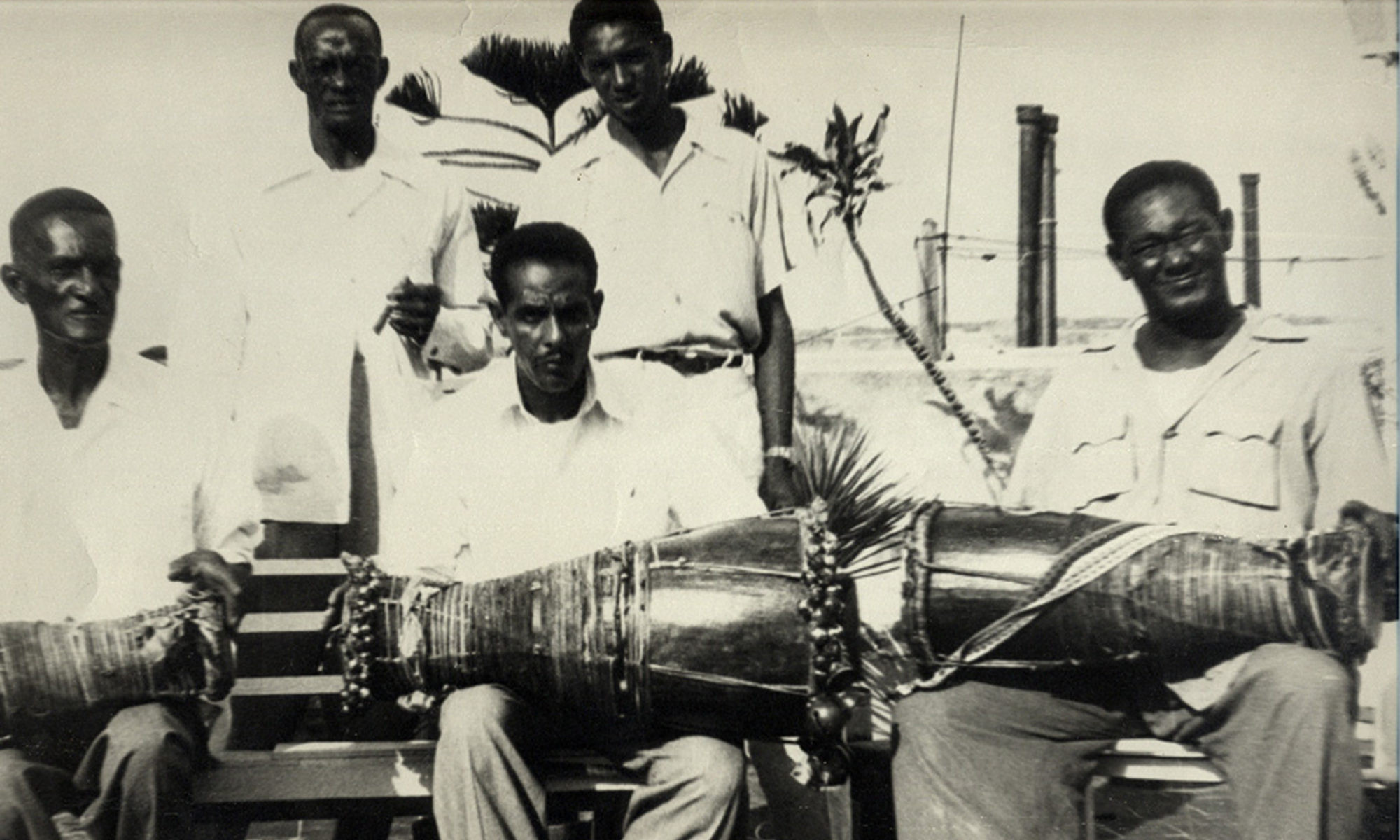Religion and the Cuban revolution:
After the revolution of 1959 led by Fidel Castro, the new Cuban Government restricted religious practice. This had a more immediate effect on Christianity than it did on the African Diaspora religions (which were practicing in secrecy as a result of centuries of persecution from the church). From 1959 to 1961 eighty percent of the professional Catholic priests and Protestant ministers left Cuba for the United States. The percentage of Afro- Cubans on the island also increased after the revolution due to an exodus of the largely white Cuban professional class.
Afro-Cuban religion:
These new religions were born out of a blending of African cultures mixing with new traditions and circumstances encountered in the ‘New World’. African Peoples were brought to Cuba as slaves during the 16th through 19th centuries to work on the sugar plantations. These slaves carried with them their own religious traditions, including sacred drum and dance that used possession trance to communicate with ancestors, systems of divination and medicine. All of these religions can trace their roots back to separate ancestries in Africa. Santeria developed out of the traditions of the Yoruba, Palo from the Congo and Abakua from southern Nigeria among others.
Another common name for Santeria in Cuba is Lucumi, a Yoruba word meaning friends. Lucumi is also the name given to descendants of Yoruba slaves in Cuba, as well as their music, dance and their Cubanized dialect of the Yoruba language.
Residing within the Yoruba cosmology is the pantheon of deities called orisha. Orisha represent the primordial forces in nature, the various archetypal human personalities, and act as personal guardians or guides to initiates of the religion. During the ceremonies (called bembés), which involve music and dance, the orisha come to earth by possessing the bodies of mediums. In this way, the orisha are able to ‘live” amongst their followers, giving them blessings and guidance.
Religion and the Cuban revolution:
After the revolution of 1959 led by Fidel Castro, the new Cuban Government restricted religious practice. This had a more immediate effect on Christianity than it did on the African Diaspora religions (which were practicing in secrecy as a result of centuries of persecution from the church). From 1959 to 1961 eighty percent of the professional Catholic priests and Protestant ministers left Cuba for the United States. The percentage of Afro- Cubans on the island also increased after the revolution due to an exodus of the largely white Cuban professional class.
Afro-Cuban religion:
These new religions were born out of a blending of African cultures mixing with new traditions and circumstances encountered in the ‘New World’. African Peoples were brought to Cuba as slaves during the 16th through 19th centuries to work on the sugar plantations. These slaves carried with them their own religious traditions, including sacred drum and dance that used possession trance to communicate with ancestors, systems of divination and medicine. All of these religions can trace their roots back to separate ancestries in Africa. Santeria developed out of the traditions of the Yoruba, Palo from the Congo and Abakua from southern Nigeria among others.
Another common name for Santeria in Cuba is Lucumi, a Yoruba word meaning friends. Lucumi is also the name given to descendants of Yoruba slaves in Cuba, as well as their music, dance and their Cubanized dialect of the Yoruba language.
Residing within the Yoruba cosmology is the pantheon of deities called orisha. Orisha represent the primordial forces in nature, the various archetypal human personalities, and act as personal guardians or guides to initiates of the religion. During the ceremonies (called bembés), which involve music and dance, the orisha come to earth by possessing the bodies of mediums. In this way, the orisha are able to ‘live” amongst their followers, giving them blessings and guidance.
Religion and the Cuban revolution:
After the revolution of 1959 led by Fidel Castro, the new Cuban Government restricted religious practice. This had a more immediate effect on Christianity than it did on the African Diaspora religions (which were practicing in secrecy as a result of centuries of persecution from the church). From 1959 to 1961 eighty percent of the professional Catholic priests and Protestant ministers left Cuba for the United States. The percentage of Afro- Cubans on the island also increased after the revolution due to an exodus of the largely white Cuban professional class.
Afro-Cuban religion:
These new religions were born out of a blending of African cultures mixing with new traditions and circumstances encountered in the ‘New World’. African Peoples were brought to Cuba as slaves during the 16th through 19th centuries to work on the sugar plantations. These slaves carried with them their own religious traditions, including sacred drum and dance that used possession trance to communicate with ancestors, systems of divination and medicine. All of these religions can trace their roots back to separate ancestries in Africa. Santeria developed out of the traditions of the Yoruba, Palo from the Congo and Abakua from southern Nigeria among others.
Another common name for Santeria in Cuba is Lucumi, a Yoruba word meaning friends. Lucumi is also the name given to descendants of Yoruba slaves in Cuba, as well as their music, dance and their Cubanized dialect of the Yoruba language.
Residing within the Yoruba cosmology is the pantheon of deities called orisha. Orisha represent the primordial forces in nature, the various archetypal human personalities, and act as personal guardians or guides to initiates of the religion. During the ceremonies (called bembés), which involve music and dance, the orisha come to earth by possessing the bodies of mediums. In this way, the orisha are able to ‘live” amongst their followers, giving them blessings and guidance.
Afro-Cuban religion:
These new religions were born out of a blending of African cultures mixing with new traditions and circumstances encountered in the ‘New World’. African Peoples were brought to Cuba as slaves during the 16th through 19th centuries to work on the sugar plantations. These slaves carried with them their own religious traditions, including sacred drum and dance that used possession trance to communicate with ancestors, systems of divination and medicine.
 All of these religions can trace their roots back to separate ancestries in Africa. Santeria developed out of the traditions of the Yoruba, Palo from the Congo and Abakua from southern Nigeria among others.
All of these religions can trace their roots back to separate ancestries in Africa. Santeria developed out of the traditions of the Yoruba, Palo from the Congo and Abakua from southern Nigeria among others.
Another common name for Santeria in Cuba is Lucumi, a Yoruba word meaning friends. Lucumi is also the name given to descendants of Yoruba slaves in Cuba, as well as their music, dance and their Cubanized dialect of the Yoruba language.Residing within the Yoruba cosmology is the pantheon of deities called orisha. Orisha represent the primordial forces in nature, the various archetypal human personalities, and act as personal guardians or guides to initiates of the religion. During the ceremonies (called bembés), which involve music and dance, the orisha come to earth by possessing the bodies of mediums. In this way, the orisha are able to ‘live” amongst their followers, giving them blessings and guidance.
Cuba, in particular, still has a phenomenal amount of sacred Yoruba music and dance. In the time of slavery, owners purposely broke up the families of slaves and mixed together people from the different African ethnic groups as a way of maintaining control. However, in early 18th century Cuba the Spanish Catholic Church created mutual aid societies, called cabildos, as a medium of entertainment and reconstruction of many aspects of their ethnic heritage. There came to be Yoruba cabildos, Congo (Bantu) cabildos and Arara (Fon) cabildos in Cuba.
Yoruba religious ceremonies were practiced and preserved in the cabildos of Cuba as the slaves seemingly synchronized their masters’ pantheon of Catholic saints with their own pantheon of orisha. Thus, the orisha covertly lived on in Cuba hiding behind a facade of Catholicism. In truth, these traditions did not exactly synchronize with Catholicism, but rather Catholicism was used as a camouflage behind which Yoruba religious practices took root and flourished. While the white slave owners observed the Africans celebrating a saint on his/her particular day, they were usually unaware that it was actually the orisha who was being worshiped.
African-Diaspora Religion Today:
African Diaspora Religions flourished in the Americas and the Caribbean. Today, the terms saint and orisha are used interchangeably in Cuba. The correlation of the Yoruba orisha with the Catholic saints is part of the island’s common culture. For example, Santa Barbara is understood to be the Yoruba orisha Changó, the god of thunder. San Lázaro is synonymous with Babalú Ayé, the orisha of infectious diseases. Consequently, the Yoruba religion in Cuba is often referred to as Santería, or the cult of the saints. Also, the Nigerian systems of divination, such as Ifá, remain intact in Cuba.
In the last thirty years issues of secrecy and gender have been challenged greatly and the exchange of information and ideas within these traditions feels very exciting and alive. Carlos came here to teach music in cultural arts centers and universities. Carlos recounts “I was thinking my trip to California would be teaching and performing in schools and going back home, but I have found a complete life here. There is Afro Cuban religion and culture here too.”
Carlos (third from left) performing Brikamo Abakua with CFNC 1963
Religion and the Cuban revolution:
After the revolution of 1959 led by Fidel Castro, the new Cuban Government restricted religious practice. This had a more immediate effect on Christianity than it did on the African Diaspora religions (which were practicing in secrecy as a result of centuries of persecution from the church). From 1959 to 1961 eighty percent of the professional Catholic priests and Protestant ministers left Cuba for the United States.
The percentage of Afro- Cubans on the island also increased after the revolution due to an exodus of the largely white Cuban professional class. Afro-Cuban religion: These new religions were born out of a blending of African cultures mixing with new traditions and circumstances encountered in the ‘New World’. African Peoples were brought to Cuba as slaves during the 16th through 19th centuries to work on the sugar plantations. These slaves carried with them their own religious traditions, including sacred drum and dance that used possession trance to communicate with ancestors, systems of divination and medicine.
All of these religions can trace their roots back to separate ancestries in Africa. Santeria developed out of the traditions of the Yoruba, Palo from the Congo and Abakua from southern Nigeria among others. Another common name for Santeria in Cuba is Lucumi, a Yoruba word meaning friends. Lucumi is also the name given to descendants of Yoruba slaves in Cuba, as well as their music, dance and their Cubanized dialect of the Yoruba language. Residing within the Yoruba cosmology is the pantheon of deities called orisha.
 Orisha represent the primordial forces in nature, the various archetypal humanpersonalities, and act as personal guardians or guides to initiates of the religion. During the ceremonies (called bembés), which involve music and dance, the orisha come to earth by possessing the bodies of mediums. In this way, the orisha are able to ‘live” amongst their followers, giving them blessings and guidance. Cuba, in particular, still has a phenomenal amount of sacred Yoruba music and dance. In the time of slavery, owners purposely broke up the families of slaves and mixed together people from the different African ethnic groups as a way of maintaining control. However, in early 18th century Cuba the Spanish Catholic Church created mutual aid societies, called cabildos, as a medium of entertainment and reconstruction of many aspects of their ethnic heritage. There came to be Yoruba cabildos, Congo (Bantu) cabildos and Arara (Fon) cabildos in Cuba. Yoruba religious ceremonies were practiced and preserved in the cabildos of Cuba as the slaves seemingly synchronized their masters’ pantheon of Catholic saints with their own pantheon of orisha. Thus, the orisha covertly lived on in Cuba hiding behind a facade of Catholicism. In truth, these traditions did not exactly synchronize with Catholicism, but rather Catholicism was used as a camouflage behind which Yoruba religious practices took root and flourished.
Orisha represent the primordial forces in nature, the various archetypal humanpersonalities, and act as personal guardians or guides to initiates of the religion. During the ceremonies (called bembés), which involve music and dance, the orisha come to earth by possessing the bodies of mediums. In this way, the orisha are able to ‘live” amongst their followers, giving them blessings and guidance. Cuba, in particular, still has a phenomenal amount of sacred Yoruba music and dance. In the time of slavery, owners purposely broke up the families of slaves and mixed together people from the different African ethnic groups as a way of maintaining control. However, in early 18th century Cuba the Spanish Catholic Church created mutual aid societies, called cabildos, as a medium of entertainment and reconstruction of many aspects of their ethnic heritage. There came to be Yoruba cabildos, Congo (Bantu) cabildos and Arara (Fon) cabildos in Cuba. Yoruba religious ceremonies were practiced and preserved in the cabildos of Cuba as the slaves seemingly synchronized their masters’ pantheon of Catholic saints with their own pantheon of orisha. Thus, the orisha covertly lived on in Cuba hiding behind a facade of Catholicism. In truth, these traditions did not exactly synchronize with Catholicism, but rather Catholicism was used as a camouflage behind which Yoruba religious practices took root and flourished.
While the white slave owners observed the Africans celebrating a saint on his/her particular day, they were usually unaware that it was actually the orisha who was being worshiped. African-Diaspora Religion Today: African Diaspora Religions flourished in the Americas and the Caribbean. Today, the terms saint and orisha are used interchangeably in Cuba. The correlation of the Yoruba orisha with the Catholic saints is part of the island’s common culture. For example, Santa Barbara is understood to be the Yoruba orisha Changó, the god of thunder. San Lázaro is synonymous with Babalú Ayé, the orisha of infectious diseases. Consequently, the Yoruba religion in Cuba is often referred to as Santería, or the cult of the saints. Also, the Nigerian systems of divination, such as Ifá, remain intact in Cuba. In the last thirty years issues of secrecy and gender have been challenged greatly and the exchange of information and ideas within these traditions feels very exciting and alive. Carlos came here to teach music in cultural arts centers and universities. Carlos recounts “I was thinking my trip to California would be teaching and performing in schools and going back home, but I have found a complete life here and Afro Cuban religion and culture is thriving here too.”
 All of these religions can trace their roots back to separate ancestries in Africa. Santeria developed out of the traditions of the Yoruba, Palo from the Congo and Abakua from southern Nigeria among others.
All of these religions can trace their roots back to separate ancestries in Africa. Santeria developed out of the traditions of the Yoruba, Palo from the Congo and Abakua from southern Nigeria among others. Orisha represent the primordial forces in nature, the various archetypal humanpersonalities, and act as personal guardians or guides to initiates of the religion. During the ceremonies (called bembés), which involve music and dance, the orisha come to earth by possessing the bodies of mediums. In this way, the orisha are able to ‘live” amongst their followers, giving them blessings and guidance. Cuba, in particular, still has a phenomenal amount of sacred Yoruba music and dance. In the time of slavery, owners purposely broke up the families of slaves and mixed together people from the different African ethnic groups as a way of maintaining control. However, in early 18th century Cuba the Spanish Catholic Church created mutual aid societies, called cabildos, as a medium of entertainment and reconstruction of many aspects of their ethnic heritage. There came to be Yoruba cabildos, Congo (Bantu) cabildos and Arara (Fon) cabildos in Cuba. Yoruba religious ceremonies were practiced and preserved in the cabildos of Cuba as the slaves seemingly synchronized their masters’ pantheon of Catholic saints with their own pantheon of orisha. Thus, the orisha covertly lived on in Cuba hiding behind a facade of Catholicism. In truth, these traditions did not exactly synchronize with Catholicism, but rather Catholicism was used as a camouflage behind which Yoruba religious practices took root and flourished.
Orisha represent the primordial forces in nature, the various archetypal humanpersonalities, and act as personal guardians or guides to initiates of the religion. During the ceremonies (called bembés), which involve music and dance, the orisha come to earth by possessing the bodies of mediums. In this way, the orisha are able to ‘live” amongst their followers, giving them blessings and guidance. Cuba, in particular, still has a phenomenal amount of sacred Yoruba music and dance. In the time of slavery, owners purposely broke up the families of slaves and mixed together people from the different African ethnic groups as a way of maintaining control. However, in early 18th century Cuba the Spanish Catholic Church created mutual aid societies, called cabildos, as a medium of entertainment and reconstruction of many aspects of their ethnic heritage. There came to be Yoruba cabildos, Congo (Bantu) cabildos and Arara (Fon) cabildos in Cuba. Yoruba religious ceremonies were practiced and preserved in the cabildos of Cuba as the slaves seemingly synchronized their masters’ pantheon of Catholic saints with their own pantheon of orisha. Thus, the orisha covertly lived on in Cuba hiding behind a facade of Catholicism. In truth, these traditions did not exactly synchronize with Catholicism, but rather Catholicism was used as a camouflage behind which Yoruba religious practices took root and flourished.